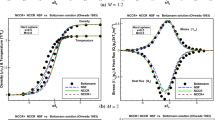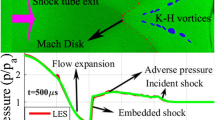Abstract
Direct Numerical Simulation (DNS) and linear analysis of a shock interacting with incompressible and compressible isotropic turbulence is conducted. A dependence of amplification ratios on the degree of compressibility of the incoming flow is found. It can be shown that the enhancement of rms values of turbulent quantities across the shock varies according to the ratio of compressible to incompressible kinetic energy ϰ (exact definition see eq. 8). Inflow conditions with high values of ϰ display reduced amplification ratios of TKE and thermodynamic quantities while vorticity fluctuations are enhanced more strongly. The different behaviour of the turbulent kinetic energy (TKE) is due to the reduced pressure diffusion term in the TKE-equation. Experiments show qualitatively a similar behaviour as the simulation with incompressible inflow conditions, but they could so far not confirm our findings of reduced amplification rates in the compressible case, one of the reasons being the lack of knowledge of all flow parameters upstream of the shock front and the inability to generate isotropic turbulence in real life experiments. For the DNS we use a third order in space shock-capturing scheme based on the ENO algorithm of Harten [10] together with an approximate Riemann solver. This non-TVD scheme turned out to have many advantages over other common Godunov-type high resolution schemes for the specific problem of a shock interacting with turbulent fields.
Similar content being viewed by others
References
Debieve, J.P. and Lacharme, J.P. In: Delery, J. (ed.),A Shock-Wave/Free Turbulence Interaction. Springer-Verlag (1986).
Erlebacher, G., Hussain, M.Y., Kreiss, H.O. and Sarkar, S., The analysis and simulation of compressible turbulence.Theor. and Comp. Fluid Dynamics 2 (1990) 73–95.
Favre, A., Equations des gaz turbulents compressibles I.J. Mec. 4 (1965) 361–390.
Friedrich, R. and Hannappel, R., On the interaction of wave-like disturbances with shocks — Two idealizations of the shock/turbulence interaction problem.Acta Mechanica, Supplement (1993).
Gorlo, B., Untersuchung der numerischen Fehler von ENO-Verfahren. Internal Report, TU München, TUM-LSM-91/26 (1991).
Hannappel R., Untersuchung zur Stabilität und zum Fehlerverhalten verschiedener Zeitintegrationsverfahren der Eulergleichungen. Internal Report, TU München, TUM-LSM-91/38 (1991).
Hannappel, R. and Friedrich, R, Interaction of isotropic turbulence with a normal shock wave.Appl. Sci. Res. 5 (1992) 507–512.
Hannappel, R., Hauser, Th. and Friedrich, R., A comparison of ENO and TVD schemes for the computation of shock-turbulence interaction.J. Comp. Phys. (submitted).
Hannappel, R., Direkte numerische Simulation der Wechselwirkung eines Verdichtungsstoßes mit isotroper Turbulenz. Ph.D. Thesis, Lehrstuhl für Fluidmechanik, TU München, F.R.G. (1993).
Harten, A., Engquist, B., Osher, St. and Chakravarthy, S.R., Uniformly high order accurate essentially non-oscillatory schemes, III.J. Comp. Phys. 71 (1987) 231–303.
Hase, R., Einfluß der Fernfeldrandbedingungen auf die numerische Lösung der instationären Eulergleichungen für umströmte Körper. Ph.D. Thesis, Lehrstuhl für Fluidmechanik, TU München, F.R.G. (1993).
Hindman, R.G., On shock capturing methods and why they work. In:AIAA 26th Aerospace Sciences Meeting, Reno, Nevada (1988).
Jacquin, L., Blin, E. and Geffroy, P., Experiments on free turbulence/shock wave interaction. In: Durst, F., Friedrich, R., Launder, B.E., Schmidt, F.W., Schuman, U. and Whitelaw, J.H. (eds),Eight Symposium on Turbulent Shear Flows, TU München. Springer-Verlag (1991).
Keller, J. and Merzkirch, W., Interaction of a normal shock wave with a compressible turbulent flow.Experiments in Fluids 8 (1990) 241–248.
Lee, S., Moin, P. and Lele, S.K., Interaction of isotropic turbulence with a shock wave. Technical Report TF-52. Thermosciences Division, Department of Mechanical Engineering, Stanford (1992).
Lee, S., Lele, S.K. and Moin, P., Direct numerical simulation of isotropic turbulence interacting with a weak shock wave.J. Fluid Mech. 251 (1993) 533–562.
McKenzi, J.F. and Westphal, K.O., Interaction of linear waves with oblique shock waves.Phys. of Fluids 11(11) (1968) 2350–2362.
Ribner, H.S., Shock-turbulence interaction and the generation of noise. NACA Report 1233 (1955).
Rochholz, H., Private communication, TU München (1993).
Sarkar, S., Erlebacher, G. and Hussaini, M. Y., Compressible homogeneous shear: Simulation and modeling. ICASE Report No. 92-6 (1992)
Shu, C.-W. and Osher, S., Efficient implementation of essentially non-oscillatory shock-capturing schemes, II.J. Comp. Phys. 83 (1989) 32–78.
Smits, A.J. and Muck, K.C., Experimental study of three shock wave/turbulent boundary layer interactions.J. Fluid Mech. 182 (1987) 291–314.
Tavoularis, I. and van Osdol, J., Velocity-derivative skewness in small Reynolds number, nearly isotropic turbulence.J. Fluid Mech. 176 33–66.
Thompson, K.W., Time dependent boundary conditions for hyperbolic systems.J. Comp. Phys. 68 (1987) 1–24.
Yee, H.C., Klopfer, G.H. and Montagne, J.-L., High-resolution shock-capturing schemes for inviscid and viscous hypersonic flows.J. Comp. Phys. 88 (1990) 31–61.
Author information
Authors and Affiliations
Rights and permissions
About this article
Cite this article
Hannappel, R., Friedrich, R. Direct Numerical Simulation of a Mach 2 shock interacting with isotropic turbulence. Appl. Sci. Res. 54, 205–221 (1995). https://doi.org/10.1007/BF00849117
Received:
Accepted:
Issue Date:
DOI: https://doi.org/10.1007/BF00849117




